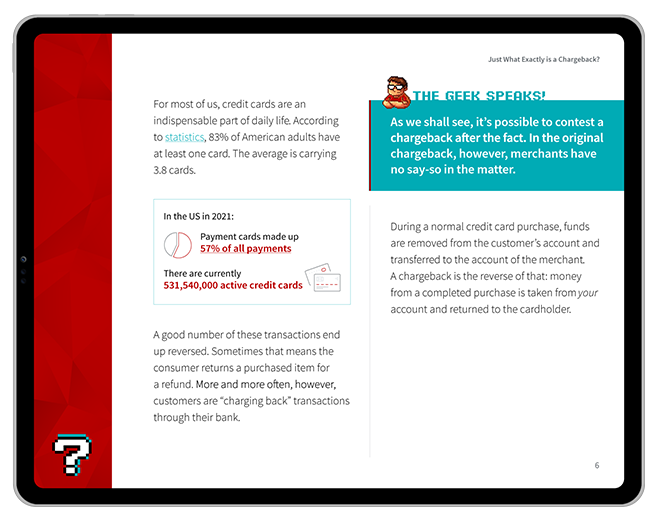What You Need to Know About Consumer Protections and Disclosures Required Under the Truth in Lending Act
Ever shopped around for a home loan or tried to find the right credit card for your specific needs? If so, then you know how overwhelming the process can be.
You have different options, different fees, and different interest rates. There’s a lot to consider. Overlooking one simple figure can cost you hundreds or even thousands of dollars.
Selecting a financing option is a big decision. And like any decision, it’s easier if you can make an “apples-to-apples” comparison between the choices. That’s the whole purpose of the Truth in Lending Act (or “TILA” for short).
This federal law was designed to ensure that all creditors disclose terms in a standardized, meaningful way. Because of TILA, consumers can more easily compare things like interest rates between lenders and also get more transparency in other aspects of lending, as we’ll see below.
Recommended reading
- Chargeback Laws: What's the Legal Basis for Card Disputes?
- American Express Chargeback Time Limits: The 2024 Guide
- Chargeback Time Limits: the Merchant's Guide for 2024
- Explaining Section 75 of the Consumer Credit Act
- What is the Restore Online Shoppers' Confidence Act?
- Discover Chargeback Time Limits: The 2024 Guide
What is the Truth in Lending Act (TILA)?
- Truth in Lending Act
The Truth in Lending Act, or TILA, serves as a safeguard for consumers in their interactions with lenders and creditors. It is a federal law that has been put into action by the Federal Reserve Board via a sequence of rules and regulations.
[noun]/trōōth • in • len • diNG • akt/President Lyndon B. Johnson officially made TILA a law in 1968. This act was introduced to shield Americans from deceitful credit agreements proposed by lenders, and give consumers a clear understanding of the real costs of credit.
One of the significant features of TILA includes the obligation for lenders to disclose key information to borrowers before offering credit. This includes facts like:
- The annual percentage rate (APR)
- The loan duration
- The total expenses and fees that the borrower would incur
- Penalties associated with certain actions like nonpayment
We’ll get further into the specifics of these requirements later. For now, just know that this crucial information should be clearly shown in all the documents given to the borrower prior to signing. This data may also be required in periodic billing statements issued to the borrower, too.
Why was the Truth in Lending Act Passed?
Under the Truth in Lending Act provisions, the borrowing and payment terms of any loan must be divulged in a predetermined manner for easier comparison. In some situations, the law also guarantees consumers the right to back out of a credit agreement without incurring a penalty.
Before the enactment of TILA, consumers were faced with a bewildering array of credit terms, fees, and rates. Basically, loan information could be provided to borrowers in any manner the creditor chose. This allowed for misrepresentation on the part of credit providers. They could even use opaque wording and confusing jargon to take advantage of borrowers.
Sometimes this involved a deliberate practice, such as offering low rates and adding extensive fees after the fact. Often, however, the confusion could be traced to different methods of calculating terms or by providing more information than a customer could realistically understand. Lenders would overload borrowers with more information than they could parse effectively.
As a result, average people were finding themselves locked into contracts far different — and far more punishing — than what they expected. TILA was created to rectify this.
How the Truth in Lending Act Works
Just as its title suggests, the Truth in Lending Act is fundamentally about promoting transparency in lending practices. This law was executed as Regulation Z (or Title 12, Chapter II, Subchapter A, Part 226 of the Code of Federal Regulations), and has been revised and broadened repeatedly over the decades since its enactment.
TILA covers most consumer credit types. This includes both closed-end credit, like home mortgages and car loans, and open-end credit, such as credit cards and home equity lines of credit. The structure of the Truth in Lending Act is organized into various sections:
Section A: Encompasses the foundational elements needed to comprehend the Act, such as construct rules and definitions.
Section B: Focuses on open-ended credit products, like credit cards and home equity loans.
Section C: Handles closed-end credit, or loans that have predetermined loan terms and a specific end date. Key elements of the loan process under this section include rules related to disclosure, the computation of the annual percentage rate, and the right of rescission.
Section D: Addresses more specific topics, including rules about verbal disclosure, state exemptions, and rate restrictions.
Section E: Contains specialized rules applicable to mortgage transactions, including practices linked to "high-cost" or "higher-priced" mortgages and stipulations for home equity plans and reverse mortgages.
The aim of these regulations is to help consumers to compare different borrowing options and protect them from deceptive or unfair lending practices. Some states have their own regulations as well, which provide additional protections.
The Federal Trade Commission (FTC) oversees the enforcement of Regulation Z. In order for lenders to offer their services to borrowers, they are required to share any details stipulated by TILA with those borrowers before finalizing any loan or credit agreement.
The term “Regulation Z” is often used interchangeably when referring to the Truth in Lending Act. So, if your lender mentions “Regulation Z,” they are likely talking about TILA provisions.
Who Does the Truth in Lending Act Apply To?
The Truth in Lending Act requirements apply to consumer transaction for which the lender is in the business of extending credit, such as a mortgage company that offers loans to purchase houses, and which meet the following criteria:
Truth in Lending Act Applies to:
- A finance charge for the loan may legally be imposed
- The borrower is a person or persons (as opposed to any type of business)
- The payment schedule includes four or more payments
- The loan is primarily for personal, family, household, or agricultural purposes.
Truth in Lending Act Doesn’t Apply to:
- Loans for which the total amount will be repaid in 3 or fewer payments
- Business loans*
- Student loans
* This generally includes even sole proprietorships or other closely-held businesses, although situations like home-based businesses may need to be decided on a case-by-case basis.
TILA violations can occur when a lender does not correctly present the financial fees and APR. They can also occur if the total quantity of payments, the schedule of payments, or penalty fees that surpass the limits set by TILA are not disclosed. Furthermore, a lender could be in breach if they deny the borrower the right to terminate the agreement within the allowed rescission period. According to TILA, a lender can face legal consequences for any such infringements.
Truth in Lending Act Applies to:
- Credit Cards
- Mortgages
- Auto Loans
Truth in Lending Act Doesn’t Apply to:
- Student Loans
- Business Loans
- Public Utilities
Credit cards were not originally covered under TILA. That changed in 1974 when the law was amended to include the Fair Credit Billing Act. While the best-known legacy of the FCBA was the introduction of chargebacks, the mandate does other things, too. It outlines the way lenders must disclose maximum interest rates and sets limits for cardholder liability in the event of fraud.
Credit card issuers were also impacted by a more recent amendment, the Credit Card Accountability Responsibility and Disclosure Act, or CARD Act. The CARD Act applies many of TILA's requirements to the issuing of new credit cards.
Before issuing a new card, financial institutions must now disclose interest rates, grace periods, and annual fees, just as they would for a closed loan. The law also states that issuers must notify cardholders of upcoming annual fees or any changes in insurance coverage.
What Information Must Be Disclosed under TILA?
So, what does the Truth in Lending Act require? In a word: transparency.
Regulation Z does not regulate how much interest a lender may charge. However, it does demand that all lenders disclose that information to the borrower up front. The rates must also be calculated and displayed in the same way. Other required disclosures include:
How the Truth in Lending Act Benefits Consumers
Basically, the Truth in Lending Act helps consumers make informed choices about credit products, including car loans, home mortgages, and credit cards. The law mandates that credit issuers clearly and conspicuously reveal the borrowing costs. It also bars lenders and credit card companies from levying “excessive” late payment fees if a borrower misses their payment deadline.
Before the enactment of TILA, certain lenders would employ misleading and exploitative strategies to entice customers into unfair agreements. With the establishment of the law, these lenders were restricted from altering specific terms and conditions of a credit contract once it has been executed.
TILA also provides consumers with the privilege to annul a contract within three days. If the contract terms are not favorable or beneficial for the consumer, they have the right to terminate and get a complete refund.
Are Truth in Lending Act Disclosures Fair?
As far as consumers go, the Truth in Lending Act protection is reasonably strong. Regulation Z disclosures ensure that customers have a much clearer view of the credit agreement before they get into it. That said, merchants haven’t been so lucky.
These mandates were created over a half-century ago. They were never designed to be adaptable to the online marketplace. Plus, with the rise of the internet and eCommerce, regulations like TILA eventually contributed to unforeseen problems like friendly fraud.
The internet has allowed borrowers and cardholders to manipulate consumer protection systems to cheat merchants out of legitimate revenue. So, while Regulation Z is necessary and effective, new mandates that accurately reflect the reality of 21st-Century merchants need to be considered.
Are you having issues with chargebacks? Contact Chargebacks911 today and learn how you can recover revenue with the benefit of a 100% ROI guarantee.














